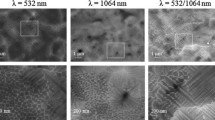Abstract
Some characteristic features observed as a result of the action of CO2 laser radiation on a metal-silicon layer are described, especially the formation of a low-resistivity penetrating layer. The assumption is put forward that this low-resistivity penetrating layer forms as a result of the solid-phase dissolution of metal in Si or by diffusion of the metal into defects formed by laser radiation.
Similar content being viewed by others
References
R. A. Weeks, J. Non-Cryst. Solids 71, 435 (1983).
A. V. Zoteev and V. F. Kiselev, Vestn. Mosk. Gos. Univ. Ser. Fiz. Astron. 28, No 1, 20 (1987).
I. W. Boyd, J. Appl. Phys. 54, 3561 (1983).
Author information
Authors and Affiliations
Additional information
Pis’ma Zh. Tekh. Fiz. 24, 60–63 (February 12, 1998)
Rights and permissions
About this article
Cite this article
Shkumbatyuk, P.S. Formation of a low-resistivity penetrating metal-Si layer under the action of CO2 laser radiation. Tech. Phys. Lett. 24, 108–109 (1998). https://doi.org/10.1134/1.1262013
Received:
Issue Date:
DOI: https://doi.org/10.1134/1.1262013



